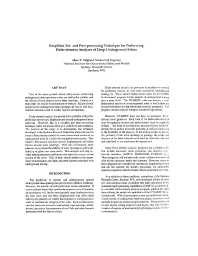Mining Publication: Simplified Pre- and Post-Processing Technique for Performing Finite-Element Analyses of Deep Underground Mines
Original creation date: August 1997
Two of the major ground control safety issues confronting underground mine operations today are shaft pillar stability and the failure of rock around active mine openings. Failure of a mine shaft can lead to the entrapment of workers. Failure of rock around active underground mine openings can lead to roof falls, which in turn can result in worker injuries and fatalities. Finite-element analysis has proven to be a reliable method for predicting stresses and displacements around underground mine openings. However, this is a complex and time-consuming technique and is not used as often as it could be in mine planning. The purpose of this paper is to demonstrate one technique developed at the Spokane Research Center that allows the user to create a finite-element model of a two-dimensional section of an underground mine in a relatively straightforward manner. This model is then used to calculate stresses, displacements, and safety factors around mine openings. With this information, mine planners can evaluate the stability of mine openings as well as the stability of pillars and mine shafts. This, in turn, should minimize the occurrence of shaft failure, roof falls, and other hazards associated with underground mining.
Authors: MT Filigenzi
Conference Paper - August 1997
NIOSHTIC2 Number: 20025259
Proceedings of the 16th International Conference on Ground Control in Mining, Peng SS, ed., Morgantown, WV: West Virginia University, 1997 Aug; :320-328
See Also
- Analysis of Multiple Seam Stability
- A Case Study of Multi-Seam Coal Mine Entry Stability Analysis with Strength Reduction Method
- Degasification System Selection for U.S. Longwall Mines Using an Expert Classification System
- The Evolution of Intelligent Coal Pillar Design: 1981-2006
- Ground Control Design for Highwall Mining
- Ground Control Research: Considering Local Geology to Improve Longwall Pillar Stability
- Multiple-Seam Mining in the United States: Background
- Pillar Strength and Design Methodology for Stone Mines
- The State-of-the-Art in Coal Pillar Design
- Using the Coal Mine Roof Rating (CMRR) to Assess Roof Stability in U.S. Coal Mines
- Page last reviewed: 9/21/2012
- Page last updated: 9/21/2012
- Content source: National Institute for Occupational Safety and Health, Mining Program


 ShareCompartir
ShareCompartir
